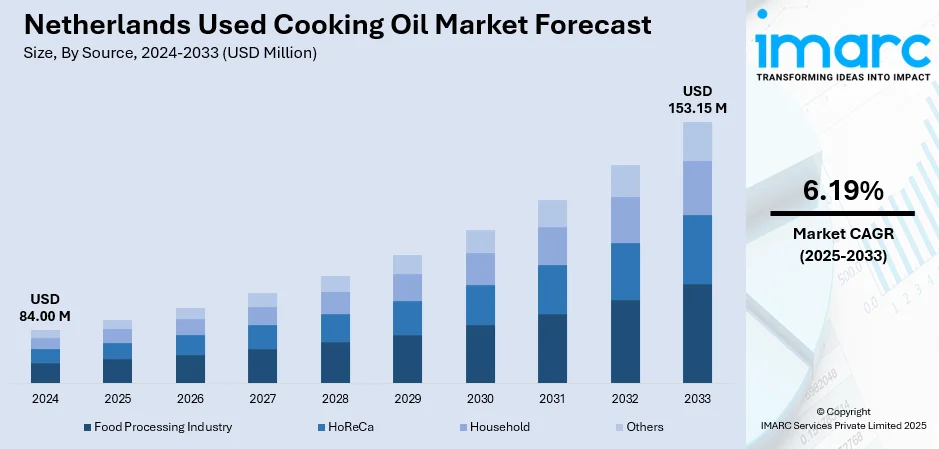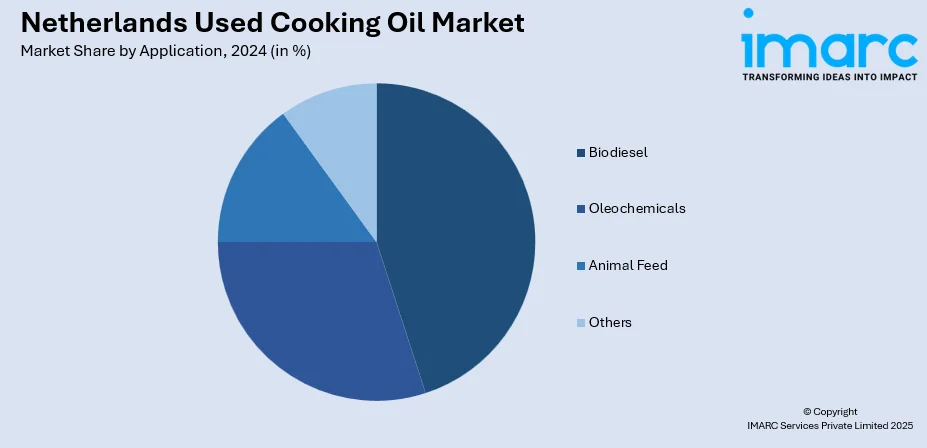
Netherlands Used Cooking Oil Market Size, Share, Trends and Forecast by Source, Application, and Region, 2025-2033
Netherlands Used Cooking Oil Market Overview:
The Netherlands used cooking oil market size reached USD 84.00 Million in 2024. The market is projected to reach USD 153.15 Million by 2033, exhibiting a growth rate (CAGR) of 6.19% during 2025-2033. As efforts to decarbonize the transport sector are growing, biodiesel is emerging as a significant alternative, with used cooking oil being a favored feedstock because of its reduced carbon footprint and cost efficiency. Besides this, the broadening of foodservice outlets is contributing to the expansion of the Netherlands used cooking oil market share.
|
Report Attribute
|
Key Statistics
|
|---|---|
|
Base Year
|
2024
|
|
Forecast Years
|
2025-2033
|
|
Historical Years
|
2019-2024
|
| Market Size in 2024 | USD 84.00 Million |
| Market Forecast in 2033 | USD 153.15 Million |
| Market Growth Rate 2025-2033 | 6.19% |
Netherlands Used Cooking Oil Market Trends:
Rising biodiesel demand
High biodiesel demand is fueling the market growth in the Netherlands. Based on figures from Statistics Netherlands (CBS), usage of biodiesel surged to 25 PJ as a result of more stringent blending regulations. With increasing efforts to decarbonize the transport sector, biodiesel has become a major alternative, and used cooking oil serves as a preferred feedstock due to its lower carbon footprint and cost-effectiveness. The Dutch government and industries are actively promoting second-generation biofuels, especially those derived from waste sources like used cooking oil, to meet EU mandates and sustainability goals. This demand has led to the establishment of advanced biodiesel production facilities and strengthened supply chain networks for collecting, processing, and converting used cooking oil into biofuel. Moreover, oil collectors and processors are investing in infrastructure to handle large volumes of used cooking oil from households. This growing demand is also incentivizing proper waste management and reducing environmental pollution. The integration of used cooking oil into the circular economy is enhancing its market relevance. Additionally, rising interest in sustainable aviation fuel (SAF), where used cooking oil is a vital raw material, is diversifying its end-use potential.

To get more information on this market, Request Sample
Increasing food delivery services
The broadening of food delivery services is bolstering the Netherlands used cooking oil market growth. As the demand for convenient meal options is growing, especially in urban areas, more restaurants, cloud kitchens, and fast-food outlets are engaging in large-scale cooking, frying, and meal preparation for takeout and delivery orders. This rise in food delivery results in increased consumption of cooking oil, particularly for fried and fast-food items, thereby generating more used cooking oil. To manage this waste responsibly and comply with environmental standards, foodservice providers are partnering with oil collection agencies that specialize in recycling and converting used cooking oil into biofuels. This growing demand is encouraging the establishment of structured collection systems, creating a steady and traceable supply chain for used cooking oil. Additionally, food delivery platforms often collaborate with restaurants that meet sustainability standards, thereby promoting proper disposal and reutilization of used cooking oil. The recurring and large-scale nature of deliveries ensures consistent oil waste generation, which supports commercial-scale biodiesel and renewable fuel production. E-commerce expansion also plays a supportive role by enabling better logistics and digital coordination between food outlets and recycling firms. As per the IMARC Group, the Netherlands e-commerce market is set to attain USD 2,987.95 Billion by 2033, exhibiting a growth rate (CAGR) of 24.97% during 2025-2033.
Netherlands Used Cooking Oil Market Segmentation:
IMARC Group provides an analysis of the key trends in each segment of the market, along with forecasts at the country and regional levels for 2025-2033. Our report has categorized the market based on source and application.
Source Insights:
- Food Processing Industry
- HoReCa
- Household
- Others
The report has provided a detailed breakup and analysis of the market based on the source. This includes food processing industry, HoReCa, household, and others.
Application Insights:

- Biodiesel
- Oleochemicals
- Animal Feed
- Others
A detailed breakup and analysis of the market based on the application have also been provided in the report. This includes biodiesel, oleochemicals, animal feed, and others.
Regional Insights:
- Noord-Holland
- Zuid-Holland
- Noord-Brabant
- Gelderland
- Utrecht
- Others
The report has also provided a comprehensive analysis of all the major regional markets, which include Noord-Holland, Zuid-Holland, Noord-Brabant, Gelderland, Utrecht, and others.
Competitive Landscape:
The market research report has also provided a comprehensive analysis of the competitive landscape. Competitive analysis such as market structure, key player positioning, top winning strategies, competitive dashboard, and company evaluation quadrant has been covered in the report. Also, detailed profiles of all major companies have been provided.
Netherlands Used Cooking Oil Market News:
- In May 2024, Neste broadened its ability to provide SAF to clients in Europe in partnership with VTTI. Neste secured terminal capacity at VTTI’s ETT terminal in Rotterdam, Netherlands, for the storage and blending of ‘Neste MY Sustainable Aviation Fuel™’. Neste’s SAF was produced from fully renewable raw materials derived from waste and residues, including used cooking oil and animal fat waste.
Netherlands Used Cooking Oil Market Report Coverage:
| Report Features | Details |
|---|---|
| Base Year of the Analysis | 2024 |
| Historical Period | 2019-2024 |
| Forecast Period | 2025-2033 |
| Units | Million USD |
| Scope of the Report |
Exploration of Historical Trends and Market Outlook, Industry Catalysts and Challenges, Segment-Wise Historical and Future Market Assessment:
|
| Sources Covered | Food Processing Industry, HoReCa, Household, Others |
| Applications Covered | Biodiesel, Oleochemicals, Animal feed, Others |
| Regions Covered | Noord-Holland, Zuid-Holland, Noord-Brabant, Gelderland, Utrecht, Others |
| Customization Scope | 10% Free Customization |
| Post-Sale Analyst Support | 10-12 Weeks |
| Delivery Format | PDF and Excel through Email (We can also provide the editable version of the report in PPT/Word format on special request) |
Key Questions Answered in This Report:
- How has the Netherlands used cooking oil market performed so far and how will it perform in the coming years?
- What is the breakup of the Netherlands used cooking oil market on the basis of source?
- What is the breakup of the Netherlands used cooking oil market on the basis of application?
- What is the breakup of the Netherlands used cooking oil market on the basis of region?
- What are the various stages in the value chain of the Netherlands used cooking oil market?
- What are the key driving factors and challenges in the Netherlands used cooking oil market?
- What is the structure of the Netherlands used cooking oil market and who are the key players?
- What is the degree of competition in the Netherlands used cooking oil market?
Key Benefits for Stakeholders:
- IMARC’s industry report offers a comprehensive quantitative analysis of various market segments, historical and current market trends, market forecasts, and dynamics of the Netherlands used cooking oil market from 2019-2033.
- The research report provides the latest information on the market drivers, challenges, and opportunities in the Netherlands used cooking oil market.
- Porter's five forces analysis assist stakeholders in assessing the impact of new entrants, competitive rivalry, supplier power, buyer power, and the threat of substitution. It helps stakeholders to analyze the level of competition within the Netherlands used cooking oil industry and its attractiveness.
- Competitive landscape allows stakeholders to understand their competitive environment and provides an insight into the current positions of key players in the market.
Need more help?
- Speak to our experienced analysts for insights on the current market scenarios.
- Include additional segments and countries to customize the report as per your requirement.
- Gain an unparalleled competitive advantage in your domain by understanding how to utilize the report and positively impacting your operations and revenue.
- For further assistance, please connect with our analysts.
 Request Customization
Request Customization
 Speak to an Analyst
Speak to an Analyst
 Request Brochure
Request Brochure
 Inquire Before Buying
Inquire Before Buying




.webp)




.webp)












